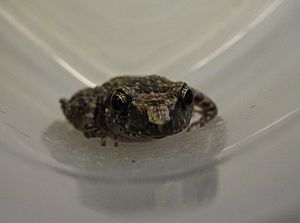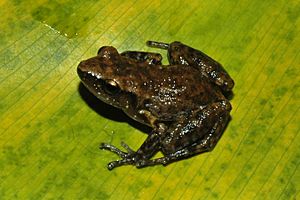Rio Grande chirping frog facts for kids
The Rio Grande chirping frog (scientific name: Eleutherodactylus cystignathoides) is a tiny frog. It is also known as the Mexican chirping frog or lowland chirping frog. This small frog lives in the southern United States, mainly in Texas. It also lives in northeastern Mexico, in states like Nuevo León, Tamaulipas, San Luis Potosí, Hidalgo, and Veracruz. These frogs have spread in Texas because they sometimes travel hidden in potted plants. There might also be a group of them living in Louisiana now.
Quick facts for kids Rio Grande chirping frog |
|
|---|---|
 |
|
| Conservation status | |
| Scientific classification | |
| Synonyms | |
|
Contents
What Does It Look Like?
These frogs are very small. Adult males are about 16 to 24 millimeters (0.6 to 0.9 inches) long. Females are slightly larger, measuring 16 to 26 millimeters (0.6 to 1.0 inch) from snout to vent. Their snout, which is their nose area, is pointed. Their body is flat and long.
You can see their eardrum, which is a round spot behind their eye. Their fingertips are a little bit wider than the rest of their fingers. The skin on their back is slightly bumpy. The skin on their belly is smooth or has small bumps. Their back can be brown, gray, or yellow-green. It often has dark spots. Their belly skin is so thin you can almost see through it. Their back legs have dark stripes across them.
How Do They Behave?
One cool thing about these frogs is that both males and females can make calls. This is unusual for frogs! The calls made by males and females sound very similar. Scientists have noticed that fewer females call compared to males. Also, the females that do call are usually smaller than those that don't.
We don't know exactly why female frogs call. It might be a way to attract a mate, just like male frogs do. Male Rio Grande chirping frogs seem to be territorial. This means they might defend their space from other male frogs.
Reproduction and Life Cycle
The Rio Grande chirping frog has a special way of reproducing. Unlike many frogs, they do not lay their eggs in water. Instead, they lay their eggs on land, usually just under the soil surface. This means their babies do not go through a tadpole stage in water.
A female frog lays between 5 and 13 eggs at a time. Each egg is quite small, about 3 to 3.5 millimeters (0.12 to 0.14 inches) wide. When the eggs hatch, tiny froglets emerge. These baby frogs are already shaped like miniature adults. They measure about 5 to 8.5 millimeters (0.2 to 0.3 inches) long when they hatch.
Where Do They Live?
These frogs live in low, flat areas near the coast and in the lower parts of hills. You can find them in places that are moist and shady. They like palm groves, thick bushes, ditches, and even in people's lawns and gardens. Many of them live in cities and towns.
During the day, they hide under things like rocks, logs, or leaves to stay safe and moist. They have also been seen resting on branches or plants about 0.2 to 1.5 meters (0.7 to 5 feet) above the ground.
Conservation Status
The Rio Grande chirping frog is quite common in the areas where it lives. There are no big threats known that would harm this species. In fact, they seem to do well even when humans are around. Some of their homes in Mexico are protected areas, like the Sierra del Abra-Tamchipa and El Cielo Biosphere Reserves. This helps ensure they have safe places to live.
See also
 In Spanish: Eleutherodactylus cystignathoides para niños
In Spanish: Eleutherodactylus cystignathoides para niños



